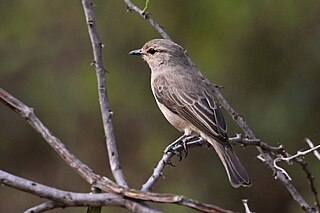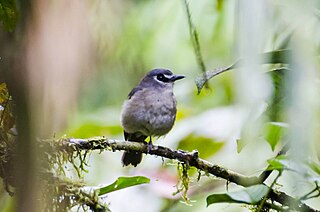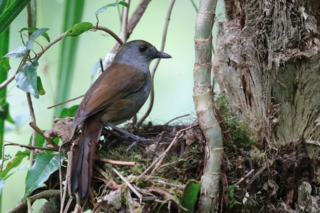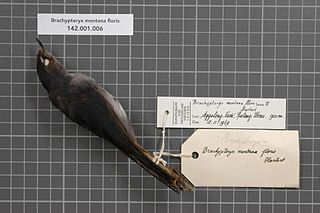
The thrushes are a passerine bird family, Turdidae, with a worldwide distribution. The family was once much larger before biologists reclassified the former subfamily Saxicolinae, which includes the chats and European robins, as Old World flycatchers. Thrushes are small to medium-sized ground living birds that feed on insects, other invertebrates, and fruit. Some unrelated species around the world have been named after thrushes due to their similarity to birds in this family.

The Old World flycatchers are a large family, the Muscicapidae, of small passerine birds restricted to the Old World, with the exception of several vagrants and two species, bluethroat and northern wheatear, found also in North America. These are mainly small arboreal insectivores, many of which, as the name implies, take their prey on the wing. The family is relatively large and includes 357 species, which are divided into 54 genera.
The shortwings are colourful medium-sized mostly insectivorous birds in the genus Brachypteryx of the thrush family Turdidae, although some taxonomists place them in the Old World Flycatcher family Muscicapidae. They show strong sexual plumage dimorphism. All are southeast Asian species.

The whistling thrushes comprise a genus Myophonus of the Old World flycatcher family Muscicapidae.

The Indian blue robin is a small bird found in the Indian Subcontinent. Formerly considered a thrush, it is now considered one of the Old World flycatchers in the family Muscicapidae. It was earlier also called the Indian blue chat. It is migratory, breeding in the forests along the Himalayas of Nepal, India, Myanmar and Bangladesh. They winter in the hill forests of the Western Ghats of India and in Sri Lanka.

The Chinese sparrowhawk (Tachyspiza soloensis) is a bird of prey in the family Accipitridae. This species was formerly placed in the genus Accipiter.

Brachypteryx is a genus of passerine birds in the family Muscicapidae containing ten species known as shortwings, that occurs in southeast Asia.

The Nilgiri blue robin, also known as Nilgiri shortwing, white-bellied shortwing, Nilgiri sholakili or rufous-bellied shortwing is a species of passerine bird in the family Muscicapidae endemic to the Shola forests of the higher hills of southern India, mainly north of the Palghat Gap. This small bird is found on the forest floor and undergrowth of dense forest patches sheltered in the valleys of montane grassland, a restricted and threatened habitat.

Gould's shortwing is a small species of passerine bird in the family Muscicapidae. It is found in the Himalayas, Yunnan and northern parts of Myanmar and Vietnam. It breeds in the eastern Himalayas in rocky areas above the tree-line and winters at lower altitude in wooded valleys.

The African grey flycatcher, grayish flycatcher, or large flycatcher is a passerine bird in the Old World flycatcher family Muscicapidae that occurs in parts of East Africa.

The slaty-backed jungle flycatcher, also known as the Goodfellow's jungle flycatcher or the Mindanao jungle flycatcher is a species of bird in the Old World flycatcher family Muscicapidae. It is endemic to the Philippines found only on the island of Mindanao. The specific epithet honours the British zoological collector Walter Goodfellow. Its natural habitat is tropical moist montane forests. It is threatened by habitat loss

The white-browed jungle flycatcher, also known as the Luzon jungle-flycatcher and the Rusty-flanked jungle-flycatcher, is a species of bird in the Old World flycatcher family Muscicapidae. It is endemic to Luzon island, in the Philippines. The natural habitat of the white-browed jungle flycatcher is tropical moist montane forests of the Cordillera Mountain Range and possibly Sierra Madre Mountains. It is threatened by habitat loss.

The white-browed bush robin is a species of passerine bird in the Old World flycatcher family Muscicapidae that is found from the Himalayas to south-central China and north Vietnam. Its natural habitat is Rhododendron and conifer forests. The Taiwan bush robin was formerly regarded as a subspecies.

The Bagobo babbler or Bagobo robin is a monotypic species of bird with its taxonomy undergoing numerous changes and is currently classified as Muscicapidae or an old world flycatcher. It is endemic to the Philippines only found in Mindanao. It was once deemed "unquestionably the Philippines most secretive bird" by ornithologist Robert Kennedy. It habitat are in moist montane forests up to 2,030 meters above sea level. It is named after the Bagobo tribe.

The white-bellied blue robin or white-bellied sholakili, is a bird of the family Muscicapidae. It is endemic to the Shola forests of the higher hills of southern India. The Nilgiri blue robin and this species were once considered separate species, later lumped as sub-species of a single species (major) and elevated again to full species in 2005 by Pamela C. Rasmussen. The species was earlier thought to be related to the shortwings and placed in the genus Brachypteryx and later moved to Myiomela since species in the genus Brachypteryx shows marked sexual dimorphism. In 2017, a study found that this is a sister group of the flycatchers in the genera Niltava, Cyornis and Eumyias among others. It was then placed in newly erected genus Sholicola. This small bird is found on the forest floor and undergrowth of dense forest patches sheltered in the valleys of montane grassland, a restricted and threatened habitat.

The Taiwan bush robin is a small passerine bird in the Old World flycatcher family Muscicapidae that is endemic to Taiwan. It was formerly considered as a subspecies of the white-browed bush robin.

The Philippine shortwing is a species of bird in the family Muscicapidae. It is endemic to the Philippines where it favours montane forest. It was once conspecific with the White-browed Shortwing.

The Bornean shortwing is a species of bird in the Old World flycatcher family Muscicapidae. It is endemic to Borneo where it favours montane forest.

The Sumatran shortwing is a species of bird in the Old World flycatcher family Muscicapidae. It is endemic to the island of Sumatra in western Indonesia where it favours montane forest.

The Flores shortwing is a species of bird in the Old World flycatcher family Muscicapidae. It is endemic to the island of Flores in the Lesser Sunda Islands where it favours montane forest.




















